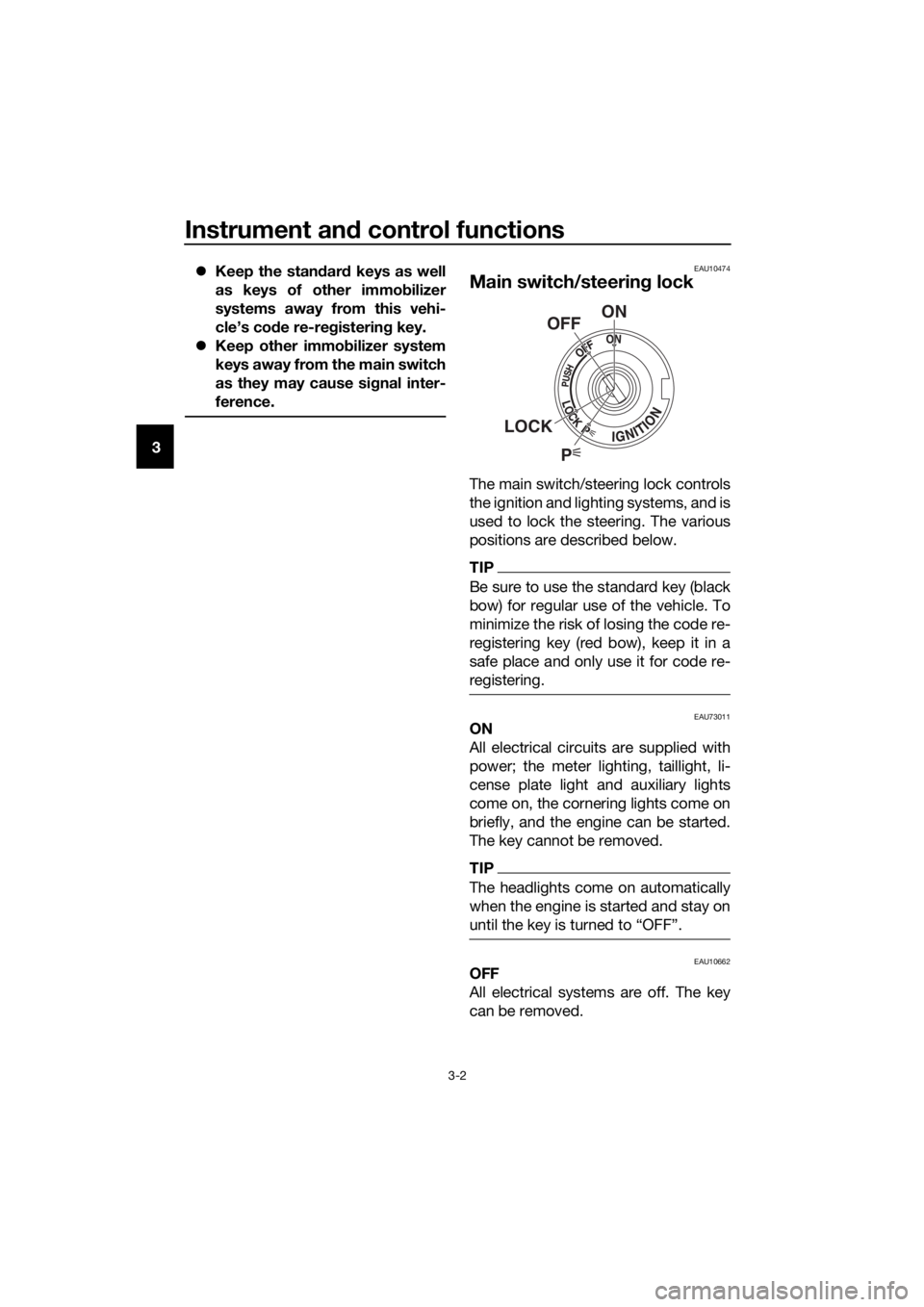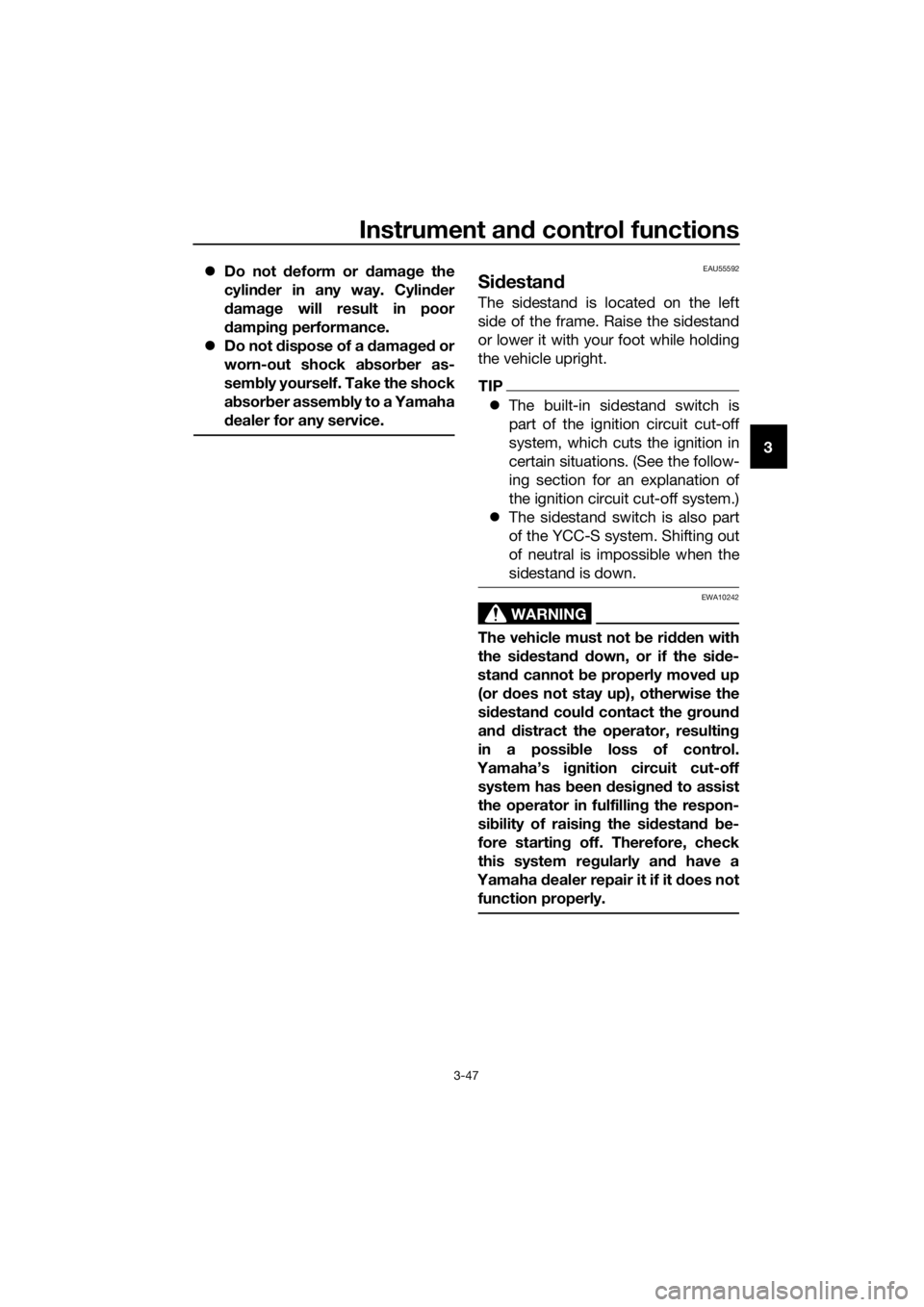2016 YAMAHA FJR1300AS ignition
[x] Cancel search: ignitionPage 5 of 126

Table of contents
Safety information ............................1-1
Description ........................................2-1
Left view ..........................................2-1
Right view........................................2-2
Controls and instruments ................2-3
Instrument an d control functions ....3-1
Immobilizer system .........................3-1
Main switch/steering lock ...............3-2
Indicator lights and warning lights ............................................3-4
Cruise control system .....................3-8
Multi-function meter unit ...............3-11
D-mode (drive mode) ....................3-23
Handlebar switches.......................3-24
YCC-S system...............................3-26
Shift pedal .....................................3-26
Hand shift lever .............................3-27
Brake lever ....................................3-28
Brake pedal ...................................3-28
ABS ...............................................3-29
Traction control system.................3-30
Fuel tank cap.................................3-31
Fuel................................................3-32
Fuel tank overflow hose ................3-33
Catalytic converters .....................3-34
Seats .............................................3-34
Adjusting the rider seat height ......3-36
Storage compartment ...................3-38
Accessory box...............................3-39
Adjusting the headlight beams......3-40
Handlebar position ........................3-40
Opening and closing the cowling vents ..........................................3-41
Rear view mirrors ..........................3-42
Adjusting the front and rear suspension.................................3-43
Sidestand ......................................3-47
Ignition circuit cut-off system........3-48
Auxiliary DC jack ...........................3-50
Cornering lights .............................3-51 For your safety – pre-operation
checks
............................................... 4-1
Operation an d important ri din g
points ................................................. 5-1
Starting the engine.......................... 5-2
Shifting ............................................ 5-3
Tips for reducing fuel consumption................................ 5-5
Engine break-in ............................... 5-6
Parking ............................................ 5-7
Perio dic maintenance an d
a d justment ........................................ 6-1
Owner’s tool kit ............................... 6-2
Periodic maintenance chart for the emission control system.............. 6-3
General maintenance and lubrication chart........................... 6-4
Removing and installing panels ...... 6-7
Checking the spark plugs ............. 6-10
Canister......................................... 6-11
Engine oil and oil filter cartridge ... 6-11
Final gear oil.................................. 6-14
Coolant ......................................... 6-15
Air filter element ............................ 6-17
Checking the engine idling
speed......................................... 6-17
Checking the throttle grip free
play ............................................ 6-18
Valve clearance ............................. 6-18
Tires .............................................. 6-19
Cast wheels .................................. 6-21
YCC-S clutch ................................ 6-22
Checking the brake lever free play ............................................ 6-22
Brake light switches ...................... 6-23
Checking the front and rear brake pads........................................... 6-23
Checking the brake and YCC-S clutch fluid levels ....................... 6-24
Changing the brake and YCC-S clutch fluids ............................... 6-26
Checking and lubricating the cables ........................................ 6-26
UB95E0E0.book Page 1 Friday, February 19, 2016 2:15 PM
Page 16 of 126

Instrument and control functions
3-2
3
Keep the stan dar d keys as well
as keys of other immo bilizer
systems away from this vehi-
cle’s cod e re-registering key.
Keep other immo bilizer system
keys away from the main switch
as they may cause si gnal inter-
ference.
EAU10474
Main switch/steerin g lock
The main switch/steering lock controls
the ignition and lighting systems, and is
used to lock the steering. The various
positions are described below.
TIP
Be sure to use the standard key (black
bow) for regular use of the vehicle. To
minimize the risk of losing the code re-
registering key (red bow), keep it in a
safe place and only use it for code re-
registering.
EAU73011ON
All electrical circuits are supplied with
power; the meter lighting, taillight, li-
cense plate light and auxiliary lights
come on, the cornering lights come on
briefly, and the engine can be started.
The key cannot be removed.
TIP
The headlights come on automatically
when the engine is started and stay on
until the key is turned to “OFF”.
EAU10662OFF
All electrical systems are off. The key
can be removed.
P
ON
OFF
LOCK
UB95E0E0.book Page 2 Friday, February 19, 2016 2:15 PM
Page 46 of 126

Instrument and control functions
3-32
3
EAU13222
Fuel
Make sure there is sufficient gasoline in
the tank.
WARNING
EWA10882
Gasoline an d g asoline vapors are
extremely flamma ble. To avoi d fires
an d explosions an d to re duce the
risk of injury when refuelin g, follow
these instructions.
1. Before refueling, turn off the en- gine and be sure that no one is sit-
ting on the vehicle. Never refuel
while smoking, or while in the vi-
cinity of sparks, open flames, or
other sources of ignition such as
the pilot lights of water heaters
and clothes dryers.
2. Do not overfill the fuel tank. When refueling, be sure to insert the
pump nozzle into the fuel tank filler
hole. Stop filling when the fuel
reaches the bottom of the filler
tube. Because fuel expands when
it heats up, heat from the engine or
the sun can cause fuel to spill out
of the fuel tank. 3. Wipe up any spilled fuel immedi-
ately. NOTICE: Immediately
wipe off spille d fuel with a clean,
d ry, soft cloth, since fuel may
d eteriorate painte d surfaces or
plastic parts.
[ECA10072]
4. Be sure to securely close the fuel tank cap.
WARNING
EWA15152
Gasoline is poisonous an d can
cause injury or death. Han dle gaso-
line with care. Never siphon gasoline
b y mouth. If you shoul d swallow
some gasoline or inhale a lot of gas-
oline vapor, or get some gasoline in
your eyes, see your doctor imme di-
ately. If gasoline spills on your skin,
wash with soap an d water. If gaso-
line spills on your clothin g, chan ge
your clothes.
EAU49743
NOTICE
ECA11401
Use only unlea ded g asoline. The use
of lead ed g asoline will cause severe
d amag e to internal en gine parts,
such as the valves an d piston rin gs,
as well as to the exhaust system.
Your Yamaha engine has been de-
signed to use regular unleaded gaso-
line with a research octane number of
1. Fuel tank filler tube
2. Maximum fuel level
Recommen ded fuel:
Regular unleaded gasoline (Gasohol
[E10] acceptable)
Fuel tank capacity: 25 L (6.6 US gal, 5.5 Imp.gal)
Fuel reserve amount:
5.5 L (1.45 US gal, 1.21 Imp.gal)
UB95E0E0.book Page 32 Friday, February 19, 2016 2:15 PM
Page 61 of 126

Instrument and control functions
3-47
3
Do not deform or damag e the
cylin der in any way. Cylin der
d amag e will result in poor
d ampin g performance.
Do not d ispose of a damag ed or
worn-out shock a bsor ber as-
sem bly yourself. Take the shock
a b sor ber assem bly to a Yamaha
d ealer for any service.
EAU55592
Si destan d
The sidestand is located on the left
side of the frame. Raise the sidestand
or lower it with your foot while holding
the vehicle upright.
TIP
The built-in sidestand switch is
part of the ignition circuit cut-off
system, which cuts the ignition in
certain situations. (See the follow-
ing section for an explanation of
the ignition circuit cut-off system.)
The sidestand switch is also part
of the YCC-S system. Shifting out
of neutral is impossible when the
sidestand is down.
WARNING
EWA10242
The vehicle must not be ri dden with
the si destan d d own, or if the si de-
stan d cannot b e properly move d up
(or does not stay up), otherwise the
si destan d coul d contact the g round
an d d istract the operator, resultin g
in a possi ble loss of control.
Yamaha’s ig nition circuit cut-off
system has been desi gne d to assist
the operator in fulfillin g the respon-
si bility of raisin g the si destan d b e-
fore startin g off. Therefore, check
this system re gularly an d have a
Yamaha dealer repair it if it does not
function properly.
UB95E0E0.book Page 47 Friday, February 19, 2016 2:15 PM
Page 62 of 126

Instrument and control functions
3-48
3
EAU68770
Ig nition circuit cut-off system
The ignition circuit cut-off system
(comprising the sidestand switch and
brake light switches) has the following
functions.
It prevents starting when the side-
stand is up, but neither brake is applied.
It prevents starting when either
brake is applied, but the sidestand
is still down.
It cuts the running engine when
the sidestand is moved down.
Periodically check the operation of the
ignition circuit cut-off system accord-
ing to the following procedure.
UB95E0E0.book Page 48 Friday, February 19, 2016 2:15 PM
Page 67 of 126

For your safety – pre-operation checks
4-2
4
Throttle grip • Make sure that operation is smooth.
• Check throttle grip free play.
• If necessary, have Yamaha dealer adjust throttle grip
free play and lubricate cable and grip housing. 6-18,
6-27
Control ca bles • Make sure that operation is smooth.
• Lubricate if necessary.
6-26
Wheels an d tires •Check for damage.
• Check tire condition and tread depth.
• Check air pressure.
• Correct if necessary. 6-19,
6-21
Brake an d shift pe dals • Make sure that operation is smooth.
• Lubricate pedal pivoting points if necessary. 6-27
Brake lever • Make sure that operation is smooth.
• Lubricate lever pivoting point if necessary. 6-28
Centerstan d, si de-
stan d • Make sure that operation is smooth.
• Lubricate pivots if necessary.
6-28
Chassis fasteners • Make sure that all nuts, bolts and screws are properly
tightened.
• Tighten if necessary. —
Instruments, li ghts,
si gnals an d switches • Check operation.
• Correct if necessary.
—
Si destan d switch • Check operation of ignition circuit cut-off system.
• If system is not working correctly, have Yamaha dealer
check vehicle. 3-47
ITEM CHECKS PAGE
UB95E0E0.book Page 2 Friday, February 19, 2016 2:15 PM
Page 69 of 126

Operation and important ri din g points
5-2
5
EAU55472
Startin g the eng ine
WARNING
EWA16411
Always apply the front or rear brake
while the main switch is in the “ON”
position an d the transmission is in
g ear. Otherwise, the vehicle may
su ddenly start to move when the en-
g ine is starte d, causin g loss of con-
trol an d possi bly an acci dent.
In order for the ignition circuit cut-off
system to enable starting, one of the
following conditions must be met:
The front or rear brake is applied
with the transmission in the neu-
tral position whether the sidestand
is up or down.
The front or rear brake is applied
with the transmission in gear and
the sidestand is up.
See page 3-48 for more informa-
tion.
1. Turn the key to “ON” and make sure that the start/engine stop
switch is set to “ ”.
The following warning lights and
indicator lights should come on for
a few seconds, then go off. Oil level warning light
Engine trouble warning light
Traction control system indi-
cator/warning light
Cruise control indicator lights
Electronically adjustable sus-
pension system warning light
Shift down indicator light
YCC-S system warning light
Stop mode function indicator
light
Immobilizer system indicator
light
TIP
If the stop mode function was activat-
ed when the key was turned to “OFF”
then the stop mode function is still ac-
tivated and the indicator light will re-
main on.
NOTICE
ECA11834
If a warnin g or in dicator li ght does
not come on initially when the key is
turne d to “ON”, or if a warnin g or in-
d icator li ght remains on, see pag e
3-4 for the correspon din g warnin g
an d in dicator li ght circuit check.
The ABS warning light should
come on when the key is turned to
“ON”, and then go off after travel-
ing at a speed of 10 km/h (6 mi/h)
or higher.
NOTICE
ECA17682
If the ABS warnin g li ght does not
come on an d then go off as ex-
plained above, see pa ge 3-4 for the
warnin g li ght circuit check.
2. Shift the transmission into the
neutral position. The neutral indi-
cator light should come on. If not,
ask a Yamaha dealer to check the
electrical circuit.
3. Start the engine by pushing the “ ” side of the start/engine
stop switch with the front or rear
brake applied.
If the engine fails to start, release
the start/engine stop switch, wait
a few seconds, and then try again.
Each starting attempt should be
as short as possible to preserve
UB95E0E0.book Page 2 Friday, February 19, 2016 2:15 PM
Page 107 of 126

Periodic maintenance an d a djustment
6-33
6
EAU54515
Replacin g the fuses
The fuse boxes and individual fuses
are located under panel A. (See page
6-7.)
If a fuse is blown, replace it as follows.1. Turn the key to “OFF” and turn off the electrical circuit in question.
2. Remove the blown fuse, and then install a new fuse of the specified
amperage. WARNING! Do not
use a fuse of a hi gher ampera ge
ratin g than recommen ded to
avoi d causin g extensive dam-
a g e to the electrical system an d
possi bly a fire.
[EWA15132]
1. Main fuse
2. Spare fuse
3. Cruise control fuse
4. Brake light fuse
5. Fuse box
6. Main fuse 2
5
1
3
4
2
5 26
1. ABS motor fuse
2. ABS solenoid fuse
3. Fuel injection system fuse
4. Backup fuse (for clock and immobilizer sys-
tem)
5. Electronic throttle valve fuse
6. Headlight fuse
7. Spare fuse
8. YCC-S motor control fuse
9. Suspension fuse
10.Signaling system fuse
11.Terminal fuse 1 (for auxiliary DC jack)
12.ABS control unit fuse
13.Ignition fuse
14.Right radiator fan motor fuse
15.Left radiator fan motor fuse
16.Hazard fuse
17.Windshield motor fuse
15 7
11
10121314
71716
8
1
9
234
5
67
7
UB95E0E0.book Page 33 Friday, February 19, 2016 2:15 PM